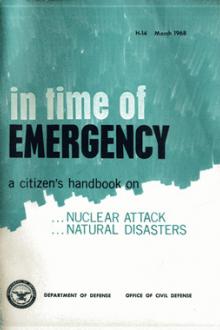In Time of Emergency, United States. Office of Civil Defense [e book reader for pc .TXT] 📗

- Author: United States. Office of Civil Defense
- Performer: -
Book online «In Time of Emergency, United States. Office of Civil Defense [e book reader for pc .TXT] 📗». Author United States. Office of Civil Defense
The Project Gutenberg EBook of In Time Of Emergency, by Department of Defense
This eBook is for the use of anyone anywhere at no cost and with
almost no restrictions whatsoever. You may copy it, give it away or
re-use it under the terms of the Project Gutenberg License included
with this eBook or online at www.gutenberg.net
Title: In Time Of Emergency
A Citizen's Handbook On Nuclear Attack, Natural Disasters (1968)
Author: Department of Defense
Release Date: February 24, 2005 [EBook #15158]
Language: English
*** START OF THIS PROJECT GUTENBERG EBOOK IN TIME OF EMERGENCY ***
Produced by Kevin Handy, John Hagerson, and the PG Online Distributed
Proofreading Team.
Illustration:
in time of
EMERGENCY
a citizen's handbook on
... NUCLEAR ATTACK
... NATURAL DISASTERS
DEPARTMENT OF DEFENSE OFFICE OF CIVIL DEFENSE
This handbook is the property of:
Name_____________________________________________
Address__________________________________________
Location of designated fallout shelter, or shelter nearest to:
Home_____________________________________________
School___________________________________________
Workplace________________________________________
Emergency telephone numbers:[1]
Ambulance________________________________________
Civil Defense____________________________________
Doctors__________________________________________
__________________________________________
Fire_____________________________________________
Health Department________________________________
Hospitals________________________________________
________________________________________
Police___________________________________________
Red Cross________________________________________
Utility Companies________________________________
________________________________
Weather Bureau___________________________________
Other____________________________________________
IN TIME OF EMERGENCY a citizen's handbook on
--NUCLEAR ATTACK
--NATURAL DISASTERS
The Office of Civil Defense gratefully acknowledges the assistance provided by representatives of the following agencies and organizations in the preparation of material for this handbook:
U.S. Atomic Energy CommissionU.S. Department of Agriculture
U.S. Department of Commerce; Environmental Science Services
Administration; Weather Bureau
U.S. Department of Health, Education, and Welfare; Public
Health Service
Office of Emergency Planning, Executive Office of the President
American Medical Association; Committee on Disaster Medical
Care
American National Red Cross
National Geographic Society
National Association of State Civil Defense Directors
United States Civil Defense Council
The Office of Civil Defense, however, is solely responsible for the validity and accuracy of the information in the handbook.
Table of Contents IntroductionPART I: NUCLEAR ATTACK
Chapter 1--Checklist of Emergency Actions
Chapter 2---Understand the Hazards of Nuclear Attack
Chapter 3--Know About Warning
Chapter 4--Fallout Shelters, Public and Private
Chapter 5--Improvising Fallout Protection
Chapter 6--Supplies for Fallout Shelters
Chapter 7--Water, Food, and Sanitation in a Shelter
Chapter 8--Fire Hazards
Chapter 9--Emergency Care of the Sick and Injured
PART II: MAJOR NATURAL DISASTERS
Chapter 1--General Guidance
Chapter 2--Floods and Hurricanes
Chapter 3--Tornadoes
Chapter 4--Winter Storms
Chapter 5--Earthquakes
Index
INTRODUCTION
A major emergency affecting a large number of people may occur anytime and anywhere.
It may be a peacetime disaster such as a flood, tornado, fire, hurricane, blizzard or earthquake. It could be an enemy nuclear attack on the United States.
In any type of general disaster, lives can be saved if people are prepared for the emergency, and know what actions to take when it occurs.
With the aid of Federal and State governments, cities and counties in all parts of the country are developing their local civil defense systems--the fallout shelters, supporting equipment and emergency plans needed to reduce the loss of life from an enemy attack.
While these local government systems have been set up mainly as safeguards against nuclear attack, they have saved lives and relieved suffering in many major peacetime disasters. People have been warned of impending storms and similar dangers, told how to protect themselves, sheltered from the elements, fed and clothed, treated for injury and illness, and given help in resuming their normal lives. Experience has shown that as cities, counties and towns develop their systems to preserve life under nuclear attack conditions, they also become better prepared to deal effectively with peacetime disasters.
In cooperation with the U.S. Office of Civil Defense and the States, many local governments are improving their civil defense systems by preparing community shelter plans. These plans include instructions to local citizens on what to do in the event of nuclear attack.
This handbook, "In Time of Emergency," contains basic general information on both nuclear attack and major natural disasters. This general guidance supplements the specific instructions issued by local governments. Since special conditions may exist in some communities, the local instructions may be slightly different from this general guidance. In those cases, the local instructions should be followed.
Part I (pages 3-68) is concerned with nuclear attack and basic actions to take.
Part II (pages 69-86) discusses preparations and emergency actions that will help individuals cope with major natural disasters--floods, hurricanes, tornadoes, winter storms, and earthquakes.
In addition to following the advice given in this handbook and the instructions of their local governments, people can prepare themselves better to meet any major disaster by taking training courses to develop their "emergency skills." Especially recommended are these courses:
"PERSONAL AND FAMILY SURVIVAL" (12-hour course)--A basic orientation course in civil defense, which also tells people how to improve their protection against the effects of a nuclear attack.
"MEDICAL SELF-HELP" (16-hour course)--How to care for the sick and injured if a doctor or nurse is not available.
"FIRST AID" (courses of various lengths)--How to help the sick and injured until professional medical assistance is obtained.
"CARE OF THE SICK AND INJURED" (12-hour course)--How to care for patients after they have received professional medical treatment.
Information on these free courses, which are given in most communities, is available from local Civil Defense Offices, County Agricultural Extension Agents, local public health departments, or American Red Cross chapters. Special advice for rural families on emergency actions related to crops and livestock is available from the U.S. Department of Agriculture.
PART ONE NUCLEAR ATTACKPART ONE NUCLEAR ATTACK
A nuclear attack against the United States would take a high toll of lives. But our losses would be much less if people were prepared to meet the emergency, knew what actions to take, and took them.
A nationwide civil defense system now exists in the United States, and is being enlarged and improved constantly. The heart of this system is fallout shelter to protect people from the radioactive fallout that would result from a nuclear attack. The system also includes warning and communications networks, preparations to measure fallout radiation, control centers to direct lifesaving and recovery operations, emergency broadcasting stations, local governments organized for emergency operations, large numbers of citizens trained in emergency skills, and U.S. military forces available to help civil authorities and the public in a time of emergency.
If an enemy should threaten to attack the United States, you would not be alone. The entire Nation would be mobilizing to repulse the attack, destroy the enemy, and hold down our own loss of life. Much assistance would be available to you--from local, State and Federal governments, from the U.S. armed forces units in your area, and from your neighbors and fellow-Americans. If an attack should come, many lives would be saved through effective emergency preparations and actions.
You can give yourself and your family a much better chance of surviving and recovering from a nuclear attack if you will take time now to:
Understand the dangers you would face in an attack.
Make your own preparations for an attack.
Learn what actions you should take at the time of attack.
Chapter 1 CHECKLIST OF EMERGENCY ACTIONS× KNOW YOUR LOCAL EMERGENCY ACTION PLAN
× Find out from your local government your local plan for emergency action.
× Determine the specific actions you and members of your family are expected to take.
× UNDERSTAND NUCLEAR ATTACK HAZARDS (See Chapter 2, page 9)
On the widespread threat of fallout, remember:
× The most dangerous period is the first 24 hours after fallout arrives. But you might have to use fallout shelter for up to two weeks.
× Highly dangerous amounts of fallout are visible. They look
like particles of sand or salt.× There is little danger that adults could inhale or swallow
enough fallout particles to hurt them. Small children, however, could be injured by drinking contaminated water or milk.× A person exposed to fallout radiation does not become radioactive. Radiation sickness is not contagious; one person cannot "catch it" from another person.
× KNOW THE ATTACK WARNING SIGNAL (See Chapter 3, page 17)
× On outdoor warning devices, the Attack Warning Signal is a 3- to 5-minute wavering sound, or a series of short blasts on whistles or horns.
Illustration:
× This signal means: An enemy attack against the United
States has been detected. Take protective action. (This signal has no other meaning, and will be used for no other purpose.)× On warning, don't use the phone. Get information from radio.
Illustration:
× KNOW THE LOCATION OF FALLOUT SHELTER (See Chapter 4, page 23)
× Public shelters are marked like this.
× Good shelters can be prepared in homes with basements.
× IF NO SHELTER IS AVAILABLE, IMPROVISE PROTECTION (See Chapter 5, page 33)
Remember:
× A basement corner below ground level, or a storm cellar, is
the best place to improvise fallout protection.× For the best possible protection, use heavy and dense materials
for shielding.× PREPARE EMERGENCY SUPPLIES (See Chapter 6, page 39)
Especially important are:
× Water and other liquids.
× Food requiring no cooking.
× Special medicines.
× CONSERVE EMERGENCY SUPPLIES; MAINTAIN SANITATION (See Chapter 7, page 45)
× REDUCE FIRE HAZARDS (See Chapter 8, page 51)
× KNOW THE BASICS OF EMERGENCY MEDICAL CARE (See Chapter 9, page 55)
If no doctor is available, especially important are actions to:
× Restore breathing.
× Stop serious bleeding.
× Treat for shock.
× Treat broken bones and burns.
× FOLLOW OFFICIAL INSTRUCTIONS
Chapter 2 UNDERSTAND THE HAZARDS OF NUCLEAR ATTACK SUMMARY
1. The main hazards of a nuclear attack are blast, heat, fire, and fallout radiation.
2. You may be able to protect yourself against blast and heat by getting inside a shelter or taking cover, before the nuclear explosions occur. You may be able to avoid fire injuries by putting out small fires or escaping from large fires that might occur in your area.
3. You can protect yourself against fallout radiation by getting inside a fallout shelter--if possible, before fallout particles begin drifting down--and by staying there until you are told to come out by authorities who have the equipment to measure radiation levels.
4. After a nuclear attack, food and water would be available to most people, and it would be usable. If any fallout particles have collected, they could be removed before the food is eaten or the water is drunk. People suffering from extreme hunger or thirst should not be denied food or water, even if the available supplies are not known to be free of fallout particles or other radioactive substances.
5. Infants and small children should be fed canned or powdered milk (if available) for awhile after the attack, unless the regular milk supply is uncontaminated. They should not be given water that may contain radioactive substances, if other water known to be pure is available.
6. A person cannot "catch" radiation sickness from another person.
UNDERSTAND THE HAZARDS OF NUCLEAR ATTACKWhen a nuclear bomb or missile explodes, the main effects produced are intense light (flash), heat, blast, and radiation. How strong these effects are depends on the size and type of the weapon; how far away the explosion is; the weather conditions (sunny or rainy, windy or still); the terrain (whether the ground is flat or hilly); and the height of the explosion (high in the air, or near the ground).
Illustration:
Illustration:
All nuclear explosions cause light, heat and blast, which occur immediately. In addition, explosions that are on or close to the ground would create large quantities of dangerous radioactive fallout particles, most of which would fall to earth during the first 24 hours. Explosions high in the air would create smaller radioactive particles, which would not have any real effect on humans until many months or years later, if at





Comments (0)